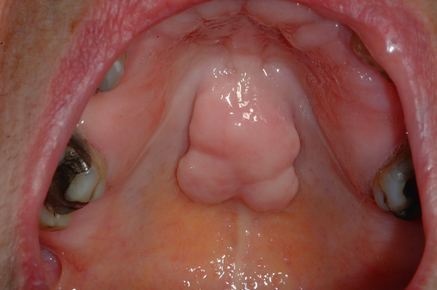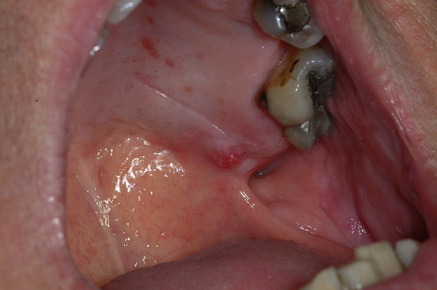Lumps and swellings in the palate
INTRODUCTION
Lumps in the palate are usually due to unerupted teeth, or bone conditions (especially torus palatinus) (Fig. 13.1). Other lumps, which warrant imaging and often biopsy, can be due to fibrous lumps, papillomas, odontogenic infections (Fig. 13.2), odontogenic cysts, nasopalatine cyst, granulomatous disorders (e.g. sarcoidosis), lymphoid hyperplasia, and neoplasms (e.g. carcinoma, melanoma, salivary neoplasms, antral neoplasms, disseminated neoplasms, lymphomas, Kaposi sarcoma) (Box 13.1).
Many of these conditions are described elsewhere in the text.
PAPILLOMA
Papilloma is a benign epithelial neoplasm with an anemone-like appearance, caused by human papillomavirus: HPV 6 or 11. Common in HIV-infected people and increased after therapy with HAART (Ch. 53), papilloma is often a small, white or pink, cauliflower-like, sessile or pedunculated lesion, < 1 cm in diameter. Most common at the junction of the hard and soft palate, the lip, gingiva or tongue may occasionally be affected. Papillomas in the mouth appear to be and remain, benign, unlike papillomas of the larynx or bowel, which may undergo malignant transformation but they are best removed and examined histologically to establish the diagnosis. Excision must be total, deep and wide enough to include any abnormal cells beyond the zone of the pedicle. Cryosurgery or pulse dye laser or carbon dioxide (CO2) laser may be used. Some use salicylic acid, imiquimod or topical podophyllum resin paint but the latter is potentially teratogenic and toxic to brain, kidney and myocardium.
Stay updated, free dental videos. Join our Telegram channel

VIDEdental - Online dental courses











